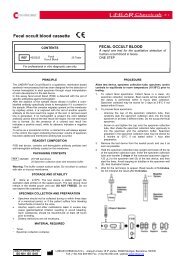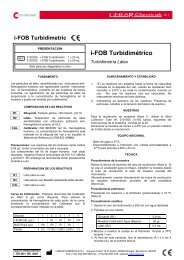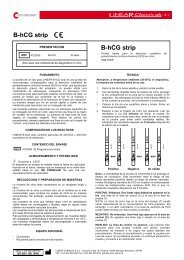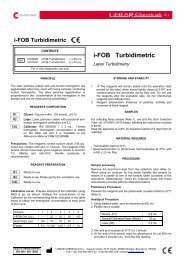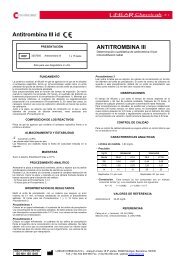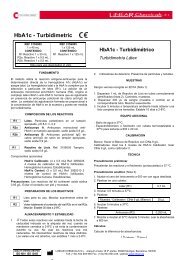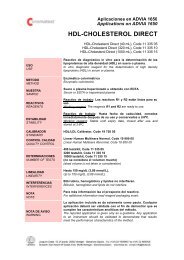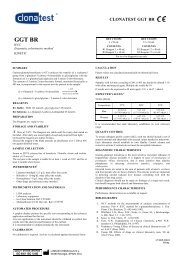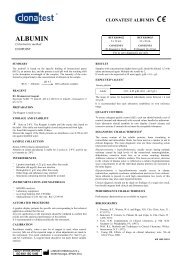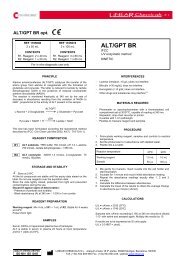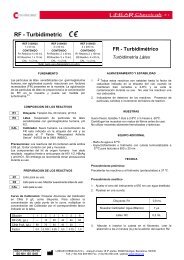IgA at - LINEAR CHEMICALS
IgA at - LINEAR CHEMICALS
IgA at - LINEAR CHEMICALS
Create successful ePaper yourself
Turn your PDF publications into a flip-book with our unique Google optimized e-Paper software.
CLONATEST <strong>IgA</strong> <strong>at</strong><br />
<strong>IgA</strong> <strong>at</strong><br />
Turbidimetric method<br />
REF CT31700<br />
REF CT31702<br />
2 x 40 mL 6 x 40 mL<br />
CONTENTS<br />
CONTENTS<br />
R1.Reagent 2 x 40 mL<br />
R1.Reagent 6 x 40 mL<br />
For in vitro diagnostic use only<br />
SUMMARY<br />
<strong>IgA</strong> <strong>at</strong> is a quantit<strong>at</strong>ive turbidimetric assay 1,2 for the measurement of <strong>IgA</strong><br />
in human serum or plasma.<br />
Anti-human <strong>IgA</strong> antibodies form insoluble complexes when mixed with<br />
samples containing <strong>IgA</strong>. The sc<strong>at</strong>tering light of the immunocomplexes<br />
depends of the <strong>IgA</strong> concentr<strong>at</strong>ion in the p<strong>at</strong>ient sample, and can be<br />
quantified by comparison from a calibr<strong>at</strong>or of known <strong>IgA</strong> concentr<strong>at</strong>ion.<br />
REAGENTS<br />
R1 <strong>IgA</strong> <strong>at</strong>. Go<strong>at</strong> antibodies anti-human <strong>IgA</strong>, tris buffer 20 mmol/L, pH 8.2.<br />
Precautions: The reagent contains sodium azide 0.95 g/L. Avoid any<br />
contact with skin or mucous.<br />
PREPARATION<br />
R1. Ready to use. 4 .<br />
Calibr<strong>at</strong>ion curve:<br />
Prepare two fold dilutions of the Calibr<strong>at</strong>or (1/1, 1/2, 1/4, 1/8) using NaCl<br />
9 g/L as diluent. Use NaCl 9 g/L as Calibr<strong>at</strong>or 0. Calcul<strong>at</strong>e the<br />
concentr<strong>at</strong>ion of each <strong>IgA</strong> Calibr<strong>at</strong>or dividing the Calibr<strong>at</strong>or concentr<strong>at</strong>ion<br />
by the corresponding dilution factor.<br />
STORAGE AND STABILITY<br />
1. The reagents will remain stable until the expir<strong>at</strong>ion d<strong>at</strong>e printed on<br />
the label. For optimal stability store tightly closed <strong>at</strong> 2-8ºC..Do not use<br />
the reagents after the expir<strong>at</strong>ion d<strong>at</strong>e.<br />
2. Presence of particles, turbidity and/or the absorbance of blank reagent<br />
REFERENCE VALUES<br />
3<br />
Adults : 70 – 400 mg/dL<br />
Newborn 4 : 0 – 2.2 mg/dL<br />
It is recommended th<strong>at</strong> each labor<strong>at</strong>ory establishes its own reference range.<br />
QUALITY CONTROL<br />
To ensure adequ<strong>at</strong>e quality control (QC), each run should include a set of<br />
controls (normal and abnormal) with assayed values handled as unknown.<br />
Each labor<strong>at</strong>ory should establish its own Quality Control scheme and<br />
corrective actions if controls do not meet the acceptable tolerances.<br />
3-5<br />
DIAGNOSTIC CHARACTERISTICS<br />
Quantific<strong>at</strong>ion of immnunoglobulins in serum is important for the diagnosis<br />
of primary or secondary immunodeficiency, for monitoring of<br />
immnuglobulin therapy, and for following the clinical course of multiple<br />
myeloma<br />
<strong>IgA</strong> represents about 10 to 15 % of the serum immunoglobulins. Its<br />
monomeric form has a similar structure th<strong>at</strong> IgG, although between 10 and<br />
15% of the total <strong>IgA</strong> is dimeric, more resistant to destruction by some<br />
p<strong>at</strong>hogenic bacteria<br />
4 .<br />
The most important form of <strong>IgA</strong> is the secretory <strong>IgA</strong>, found in tears,<br />
swe<strong>at</strong>, saliva, milk, colostrums and gastrointestinal and bronchial<br />
secretions.<br />
Congenital and acquired immunodeficiency are the most important causes<br />
of <strong>IgA</strong> deficit.<br />
Polyclonal hyperimmunoglobulinemia (normal response to infections),<br />
skin, gut, respir<strong>at</strong>ory and renal infections as well as cirrhosis are causes<br />
> 0.3 <strong>at</strong> 340 nm are sign of deterior<strong>at</strong>ion. th<strong>at</strong> increase <strong>IgA</strong> concentr<strong>at</strong>ion<br />
4 .<br />
Increments of monoclonal <strong>IgA</strong> (paraprotein) are found in multiple<br />
SAMPLE COLLECTION myeloma, and prolifer<strong>at</strong>ive disorders of plasma cells<br />
4 .<br />
Fresh serum and EDTA or heparinized plasma.<br />
<strong>IgA</strong> in serum or plasma is stable 7 days <strong>at</strong> 2-8ºC or 3 months <strong>at</strong> –20ºC.<br />
Samples with presence of fibrin should be centrifuged before testing. Highly<br />
hemolyzed or lipemic samples are not suitable for testing.<br />
INTERFERENCES<br />
−<br />
Bilirubin (10 mg/dL) does not interfere. Hemoglobin (4 g/L),<br />
rheum<strong>at</strong>oid factors (200 IU/mL) and lipemia (1.25 g/L) may affect the<br />
results. Other substances may interfere<br />
ADDITIONAL EQUIPMENT<br />
−<br />
Analyzer LIDA.<br />
5 .<br />
PERFORMANCE CHARACTERISTICS<br />
Performance characteristics are available on request.<br />
NOTES<br />
1. The linearity limit depends on the sample/reagent r<strong>at</strong>io, as well as the<br />
analyzer used. It will be higher by decreasing the sample volume,<br />
although the sensitivity of the test will be proportionally decreased.<br />
2. Clinical diagnosis should not be made on findings of a single test result,<br />
but should integr<strong>at</strong>e both clinical and labor<strong>at</strong>ory d<strong>at</strong>a.<br />
BIBLIOGRAPHY<br />
1. Narayanan S. Clin Chem 128: 1528-1531 (1982).<br />
AUTHOMATIC TECHNIQUE 2. Price CP et al. Ann Clin Biochem 20: 1-14 (1983).<br />
For autom<strong>at</strong>ic assays the applic<strong>at</strong>ion method is included.<br />
3. D<strong>at</strong>i F et al. Eur J Clin Chem Clin Biochem 34 : 517-520 (1996).<br />
rd<br />
Any applic<strong>at</strong>ion to an instrument should be valid<strong>at</strong>ed to demonstr<strong>at</strong>e th<strong>at</strong> 4. Tietz Textbook of Clinical Chemistry, 3 Ed. Burtis CA, Ashwood<br />
results meet the performance characteristics of the method.<br />
ER. WB Saunders Co., (1999).<br />
It is recommended to valid<strong>at</strong>e periodically the instrument.<br />
5. Young DS. Effects of drugs on clinical labor<strong>at</strong>ory tests. 3th ed. AACC<br />
CALIBRATION<br />
Recalibr<strong>at</strong>e weekly, when a new lot of reagent is used, when control<br />
recovery falls out of the expected range or when adjustments are made to<br />
the instrument. A reagent blank should be run daily before sample<br />
analysis.<br />
Press (1997).<br />
6. Friedman and Young. Effects of the disease on clinical labor<strong>at</strong>ory<br />
tests, 3th ed. AACC Press, 1997.<br />
CT31700-1/0703<br />
R1<br />
QUALITY SYSTEM CERTIFIED<br />
ISO 9001 ISO 13485<br />
<strong>LINEAR</strong> <strong>CHEMICALS</strong> S.L.<br />
08390 Montg<strong>at</strong>, SPAIN (EU)
CLONATEST <strong>IgA</strong> <strong>at</strong><br />
<strong>IgA</strong> <strong>at</strong><br />
Método turbidimétrico<br />
REF CT31700<br />
REF CT31702<br />
2 x 40 mL 6 x 40 mL<br />
CONTENIDO<br />
CONTENIDO<br />
R1.Reactivo 2 x 40 mL R1.Reactivo 6 x 40 mL<br />
Sólo para uso diagnóstico in vitro<br />
FUNDAMENTO<br />
<strong>IgA</strong> <strong>at</strong> es un ensayo turbidimétrico 1,2 para la cuantificación de <strong>IgA</strong> en<br />
suero o plasma humanos.<br />
Los anticuerpos anti-<strong>IgA</strong> humana forman inmunocomplejos con la <strong>IgA</strong><br />
presente en la muestra del paciente, ocasionando una dispersión de luz<br />
proporcional a la concentración de <strong>IgA</strong> y que puede cuantificarse por<br />
comparación con un calibrador de concentración conocida.<br />
REACTIVOS<br />
R1 <strong>IgA</strong> <strong>at</strong>. Anticuerpos de cabra anti-<strong>IgA</strong> humana en tampón tris 20<br />
mmoL/L, pH 8,2.<br />
Precauciones: El reactivo contiene azida sódica 0,95 g/L. Evitar contacto<br />
con piel y mucosas.<br />
PREPARACION<br />
R1. Listo para su uso.<br />
Curva de Calibración: Preparar dobles diluciones del Calibrador (1/1, 1/2,<br />
1/4, 1/8) en ClNa 9 g/L como diluyente. Usar ClNa 9 g/L como Calibrador<br />
0. Calcular la concentración de cada dilución del Calibrador de <strong>IgA</strong><br />
dividiendo la concentración del Calibrador por el correspondiente factor de<br />
dilución.<br />
ALMACENAMIENTO Y ESTABILIDAD<br />
1. Todos estos reactivos son estables hasta la fecha de caducidad<br />
indicada en la etiqueta del vial. Para una estabilidad optima mantener<br />
los reactivos bien cerrados y conservados a 2-8ºC. No usar los<br />
reactivos una vez caducados.<br />
2. La presencia de partículas, turbidez y/o una absorbancia del blanco de<br />
reactivo > 0,3 a 340 nm es indic<strong>at</strong>ivo de deterioro.<br />
Se recomienda hacer un blanco del reactivo cada día de trabajo antes de<br />
analizar las muestras.<br />
VALORES DE REFERENCIA<br />
Adultos 3 : 70 - 400 mg/dL<br />
Neon<strong>at</strong>os 4 : 0 – 2,2 mg/dL<br />
Es recomendable que cada labor<strong>at</strong>orio establezca sus propios valores de<br />
referencia.<br />
CONTROL DE CALIDAD<br />
Para un control de calidad adecuado se incluirán en cada serie controles<br />
valorados (normal y p<strong>at</strong>ológico) que se tr<strong>at</strong>arán como muestras problema.<br />
Cada labor<strong>at</strong>orio debería establecer su propio Control de Calidad y<br />
establecer correcciones en el caso que los controles no cumplan con las<br />
tolerancias exigidas.<br />
3-5<br />
SIGNIFICADO CLINICO<br />
La cuantificación de las inmunoglobulinas en suero es importante para el<br />
diagnóstico de la inmunodeficiencia primaria y secundaria, la monitorización<br />
de la terapia, y el seguimiento del curso del mieloma múltiple 4 .<br />
La <strong>IgA</strong> representa entre un 10 y 15% de todas las immunoglobulinas. Su<br />
forma monomérica tiene una estructura parecida a la IgG, aunque entre un<br />
10-15% del total de <strong>IgA</strong> es de forma dimérica, mucho más resistente a la<br />
destrucción por algunas bacterias p<strong>at</strong>ógenas<br />
4 .<br />
Una forma especial de <strong>IgA</strong>, denominada secretora, se halla en saliva,<br />
lágrimas, sudor, leche y otras secreciones gástricas y bronquiales.<br />
La hiperglobulinemia policlonal (respuesta normal a las infecciones)<br />
incrementa el valor de <strong>IgA</strong> especialmente en las infecciones de la piel,<br />
pulmones, riñón y cirrosis hepática 4 .<br />
En el mieloma múltiple y otras alteraciones de las células plasmáticas, se<br />
observa una aumento de la concentración de <strong>IgA</strong> monoclonal<br />
(paraproteinas)<br />
MUESTRAS<br />
Suero fresco o plasma recogido con heparina o EDTA como<br />
anticoagulantes. 4<br />
La <strong>IgA</strong> es estable en suero o plasma 7 días a 2-8ºC o 3 meses a -20ºC.<br />
.<br />
Centrifugar las muestras con restos de fibrina antes de usar.<br />
No utilizar muestras altamente hemolizadas o lipémicas.<br />
CARACTERISTICAS ANALITICAS<br />
Las características analíticas están disponibles bajo solicitud.<br />
INTERFERENCIAS<br />
NOTAS<br />
− La bilirrubina (10 mg/dL), no interfiere. La hemoglobina (4 g/L), los<br />
factores reum<strong>at</strong>oides (200 UI/mL) y los lípidos (1,25 g/L), pueden 1. La linealidad del ensayo depende de la relación muestra/reactivo y<br />
afectar los resultados. Otras sustancias pueden interferir<br />
5 .<br />
analizador utilizado. Disminuyendo el volumen de muestra, se aumenta el<br />
límite superior de linealidad, aunque se reduce la sensibilidad.<br />
EQUIPO ADICIONAL<br />
−<br />
Analizador LIDA.<br />
TECNICA AUTOMATICA<br />
Seguir las instrucciones incluidas en la adaptación del analizador.<br />
Cualquier adaptación a un instrumento deberá ser validada con el fin de<br />
demostrar que se cumplen las características analíticas del método.<br />
Se recomienda validar periódicamente el instrumento.<br />
CALIBRACION<br />
Recalibrar semanalmente, al cambiar el lote de reactivos, cuando los<br />
valores del control estén fuera del rango de aceptación o cuando se<br />
realicen ajustes en el instrumento.<br />
2. El diagnóstico clínico no debe realizarse únicamente con los resultados<br />
de un único ensayo, sino que debe considerarse al mismo tiempo los<br />
d<strong>at</strong>os clínicos del paciente.<br />
REFERENCIAS<br />
1. Narayanan S. Clin Chem 128: 1528-1531 (1982).<br />
2. Price CP et al. Ann Clin Biochem 20: 1-14 (1983).<br />
3. D<strong>at</strong>i F et al. Eur J Clin Chem Clin Biochem 34:517-520 (1996).<br />
4. Tietz Textbook of Clinical Chemistry, 3 rd Ed. Burtis CA, Ashwood ER.<br />
WB Saunders Co., (1999).<br />
5. Young DS. Effects of drugs on clinical labor<strong>at</strong>ory tests. 3th ed. AACC<br />
Press (1997).<br />
6. Friedman and Young. Effects of the disease on clinical labor<strong>at</strong>ory tests,<br />
3th ed. AACC Press, 1997.<br />
QUALITY SYSTEM CERTIFIED<br />
ISO 9001 ISO 13485<br />
<strong>LINEAR</strong> <strong>CHEMICALS</strong> S.L.<br />
08390 Montg<strong>at</strong>, SPAIN (EU)



